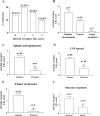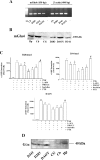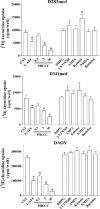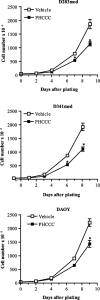Pharmacological activation of mGlu4 metabotropic glutamate receptors inhibits the growth of medulloblastomas
- PMID: 16899734
- PMCID: PMC6673797
- DOI: 10.1523/JNEUROSCI.2285-06.2006
Pharmacological activation of mGlu4 metabotropic glutamate receptors inhibits the growth of medulloblastomas
Abstract
Moving from the evidence that activation of type 4 metabotropic glutamate (mGlu4) receptors inhibits proliferation and promotes differentiation of cerebellar granule cell neuroprogenitors, we examined the expression and function of mGlu4 receptors in medulloblastoma cells. mGlu4 receptors were expressed in 46 of 60 human medulloblastoma samples. Expression varied in relation to the histotype (nodular desmoplastic>classic>>large-cell anaplastic) and was inversely related to tumor severity, spreading, and recurrence. mGlu4 receptors were also found in D283med, D341med, and DAOY medulloblastoma cell lines, where receptor activation with the selective enhancer PHCCC inhibited adenylyl cyclase and the phosphatidylinositol-3-kinase pathway without affecting the mitogen-activated protein kinase, Sonic Hedgehog, and Wnt pathways. Interestingly, mGlu4 receptor activation reduced DNA synthesis and cell proliferation in all three cell lines. This effect was abrogated by the phosphatidylinositol-3-kinase inhibitor LY294002 [2-(4-morpholinyl)-8-phenyl-4H-1-benzopyran-4-one]. In in vivo experiments, repeated subcutaneous injections of N-phenyl-7-(hydroxyimino)cyclopropa[b]chromen-1a-carboxamide (PHCCC) reduced the growth of D283med and DAOY cell xenografts in nude mice. More remarkably, subcutaneous or intracranial injections of PHCCC during the first week of life prevented the development of medulloblastomas in mice lacking one Patched-1 allele and x-irradiated 1 d after birth. These data suggest that mGlu4 receptor enhancers are promising drugs for the treatment of medulloblastomas.
Figures









Similar articles
-
PHCCC, a specific enhancer of type 4 metabotropic glutamate receptors, reduces proliferation and promotes differentiation of cerebellar granule cell neuroprecursors.J Neurosci. 2004 Nov 17;24(46):10343-52. doi: 10.1523/JNEUROSCI.3229-04.2004. J Neurosci. 2004. PMID: 15548648 Free PMC article.
-
Pharmacological activation of mGlu4 metabotropic glutamate receptors reduces nigrostriatal degeneration in mice treated with 1-methyl-4-phenyl-1,2,3,6-tetrahydropyridine.J Neurosci. 2006 Jul 5;26(27):7222-9. doi: 10.1523/JNEUROSCI.1595-06.2006. J Neurosci. 2006. PMID: 16822979 Free PMC article.
-
Anxiolytic-like effects of PHCCC, an allosteric modulator of mGlu4 receptors, in rats.Eur J Pharmacol. 2004 Sep 13;498(1-3):153-6. doi: 10.1016/j.ejphar.2004.07.001. Eur J Pharmacol. 2004. PMID: 15363989
-
Targeting metabotropic glutamate receptors in the treatment of primary brain tumors.Curr Opin Pharmacol. 2018 Feb;38:59-64. doi: 10.1016/j.coph.2018.02.005. Epub 2018 Mar 8. Curr Opin Pharmacol. 2018. PMID: 29525720 Review.
-
Photopharmacological manipulation of amygdala metabotropic glutamate receptor mGlu4 alleviates neuropathic pain.Pharmacol Res. 2023 Jan;187:106602. doi: 10.1016/j.phrs.2022.106602. Epub 2022 Dec 15. Pharmacol Res. 2023. PMID: 36529205 Review.
Cited by
-
An Overview of the Molecular Cues and Their Intracellular Signaling Shared by Cancer and the Nervous System: From Neurotransmitters to Synaptic Proteins, Anatomy of an All-Inclusive Cooperation.Int J Mol Sci. 2022 Nov 24;23(23):14695. doi: 10.3390/ijms232314695. Int J Mol Sci. 2022. PMID: 36499024 Free PMC article. Review.
-
Therapeutic avenues for cancer neuroscience: translational frontiers and clinical opportunities.Lancet Oncol. 2022 Feb;23(2):e62-e74. doi: 10.1016/S1470-2045(21)00596-9. Lancet Oncol. 2022. PMID: 35114133 Free PMC article. Review.
-
Allosteric modulation of metabotropic glutamate receptors.Adv Pharmacol. 2011;62:37-77. doi: 10.1016/B978-0-12-385952-5.00010-5. Adv Pharmacol. 2011. PMID: 21907906 Free PMC article. Review.
-
mGlu Receptors and Cancerous Growth.Wiley Interdiscip Rev Membr Transp Signal. 2012 Mar;1(2):211-220. doi: 10.1002/wmts.21. Epub 2011 Oct 25. Wiley Interdiscip Rev Membr Transp Signal. 2012. PMID: 22662310 Free PMC article.
-
Expression of glutamate receptor subunits in human cancers.Histochem Cell Biol. 2009 Oct;132(4):435-45. doi: 10.1007/s00418-009-0613-1. Epub 2009 Jun 14. Histochem Cell Biol. 2009. PMID: 19526364
References
-
- Aronica E, Gorter JA, Jansen GH, van Veelen CW, van Rijen PC, Ramkema M, Troost D (2003). Expression and cell distribution of group I and group II metabotropic glutamate receptor subtypes in Taylor-type focal cortical dysplasia. Epilepsia 44:785–795. - PubMed
-
- Baeza N, Masuoka J, Kleihues P, Ohgaki H (2003). AXIN1 mutations but not deletions in cerebellar medulloblastomas. Oncogene 22:632–636. - PubMed
-
- Battaglia G, Busceti CL, Molinaro G, Biagioni F, Traficante F, Nicoletti F, Bruno V (2006). Pharmacological activation of mGlu4 metabotropic glutamate receptors reduces nigro-striatal degeneration in mice treated with 1-methyl-4-phenyl-1,2,3,6-tetrahydropyridine. J Neurosci 26:7222–7229. - PMC - PubMed
-
- Berman DM, Karhadkar SS, Hallahan AR, Pritchard JI, Eberhart CG, Watkins DN, Chen JK, Cooper MK, Taipale J, Olson JM, Beachy PA (2002). Medulloblastoma growth inhibition by hedgehog pathway blockade. Science 297:1559–1561. - PubMed
-
- Bettini E, Magnani E, Terstappen GC (2002). Lithium induces gene expression through lymphoid enhancer-binding factor/T-cell factor responsive element in rat PC12 cells. Neurosci Lett 317:50–52. - PubMed
Publication types
MeSH terms
Substances
LinkOut - more resources
Full Text Sources
Other Literature Sources
